Humans come in all shapes and sizes. The average human shape doesn’t exist, even though society likes to create its ideals. When it comes to the female body, traditionally, the different varieties have been described by shapes as well as by fruit. Even though it’s possible to classify body types according to these categories, this is by no means an exact science. There is usually some overlap between the different types, and there is even quite a lot of variation within each type. However, you should be able to identify yourself in one of the body types.
In this article, we explore the ten most common female body shapes. We’ll also provide guidelines on how to identify which body type you are, provide tips on how to dress according to your body shape, and answer the most frequently asked questions on female body shapes.
10 Common Female Body Shapes
There are five main body shapes, with the other five being variants of them.
Those five basic shapes are:
- Rectangle or Banana
- Triangle or Pear
- Inverted Triangle or Apple
- Hourglass
- Athletic
Fruits are often used to represent body shapes because they are easy for us to visualize. Let’s now break down the main female body shapes.
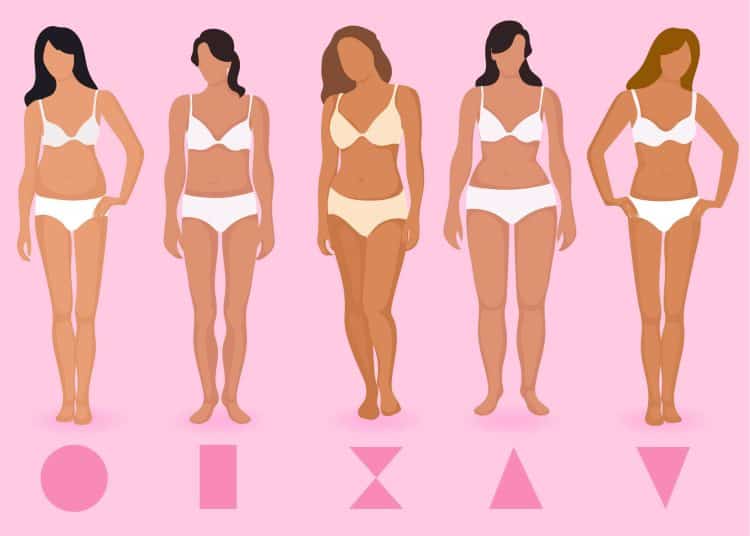
1. Hourglass Body Shape
The hourglass body shape is considered well-balanced, having a bust and hips that are about the same size and a narrow waistline. This creates the classic hourglass figure. The bust is large and rounded, and the hips are curvy. The hips and shoulders are aligned.
Dressing tips for the hourglass figure:
- Make the most of what you’ve got by accentuating the curves. Do this by wearing high-waisted pants, wrap dresses, and tops with belts.
- Go for fitted silhouettes that hug your body but are not overly tight.
- Opt for V-necklines or scoop necks that will accentuate your hourglass figure.
- Wear flared bottoms or bootcut jeans to provide lower body volume.
- Strategically employ layers to provide dimensions and depth. This could include adding a jacket, scarf, or blazer to your ensemble.
- Stay away from shapeless outfits.
- Experiment with a range of patterns, including stripes, color blocks, and prints.
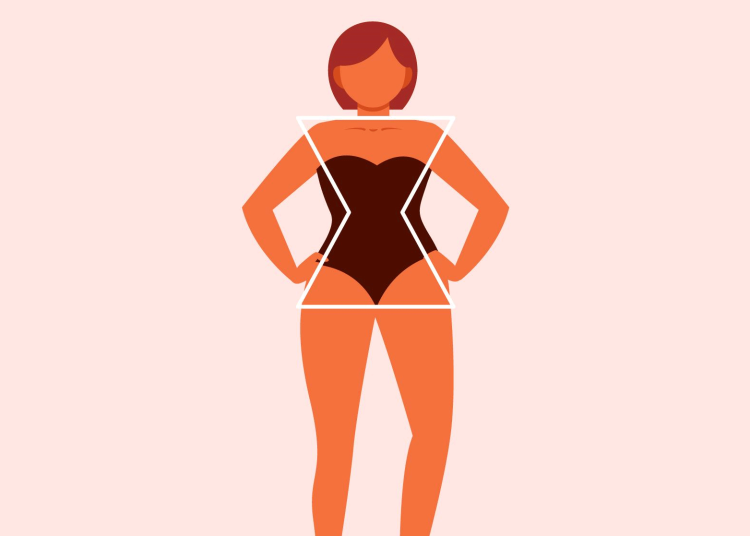
2. Pear Body Shape
The pear body shape is typified by narrow shoulders and bust and comparatively wide hips and thighs. This creates a lower body-heavy look that resembles an inverted triangle. The butt is generally rounded, and the waist is well-defined.
Dressing tips for the pear body:
- Balance out the lower and upper body by choosing wide, detailed tops with embellishments like patterns and ruffles.
- Wear off-the-shoulder tops and wide necklines.
- Buy A-line and flared skirts that gradually flare down from the waist.
- Go for dark lower body colors with lighter color tops.
- Wear jeans with a straight flare to create a streamlined appearance from the hips to the thighs.
- Look for structured fabrics to give the impression of a smooth silhouette.
- Wear such statement accessories as scarves, chunky necklaces, and earrings.
- Invest in form-fitting undergarments, including a well-fitted bra.
3. Apple Body Shape
The apple or inverted triangle body shape is identified by wide shoulders, a large bust, and narrow hips. The legs are generally proportionally smaller than the upper body, and the person tends to carry a bit of excess weight around the middle.
Dressing tips for the apple body:
- Your goal should be to lengthen the body and draw the focus away from the midsection. You can do this by emphasizing your legs with above-the-knee skirts and tailored pants.
- Select tops and dresses with an A-line silhouette to produce a slimmer waistline effect.
- Employ draping around the midsection to cover undesirable areas.
- Wear dresses and tops with an open V-neckline to emphasize the width of the upper torso.
- Stay away from high-waisted bottoms.
- Opt for structured fabrics rather than form-fitting materials.
- Use layers, such as a fitted jacket, to draw attention away from your midsection.
- Wear off-the-shoulder tops, necklaces, or detailed sleeves to emphasize the upper torso.
- Wear a well-fitted bra that will lift and support the bust.
- Wear flared pants that can help balance your proportions.
4. Rectangle Body Shape
The rectangular body shape is characterized by bust, waist, and hip measurements that are about the same. The shoulders are essentially straight, and the butt could be considered to be flat. The rectangular body shape bust could be considered small, yet the shape is generally recognized as athletic.
Dressing tips for the rectangle body:
- Create the illusion of a defined waist by wearing a belt or choosing clothing with cinching or ruching.
- Choose structured clothing such as tops with pleats, seams, or darts.
- Wear a variety of necklines to help balance your figure. Experiment with things like V-necklines, scoop necks, and boat necks.
- Make use of layering to add depth and dimension. Do this with jackets, vests, or cardigans.
- Go for skirts or pants with such details as ruffles or pleats to help balance out the upper and lower body.
- Experiment with print and patterns.
- Add accessories like chunky necklaces, scarves, or bold belts to add interest.

5. Athletic Body Shape
The athletic body shape is characterized by being lean, muscular, and defined. It lacks the curves and hourglass shape of some of the other body shapes but looks fitter and healthier. The waist is narrow with a tight, defined midsection, and the hips are structurally narrower than the shoulders to accentuate a V-taper.
Dressing tips for the athletic body:
- Accentuate the midsection by wearing a belt, cinched clothing, and wraps that detail at the waist.
- Go for figure-hugging outfits that highlight your physique.
- Choose clothes with such details as ruffles, bows, and pleats that may accentuate your curves.
- Wear sweetheart and scoop necklines to enhance your curves.
- Wear flared pants and skirts to help balance the upper and lower body.
- Use layers to add depth to your silhouette by wearing a jacket or vest.
- Experiment with dresses and tops that feature diagonal lines.
- Wear high-waisted pants and skirts to enhance your curves.
6. Inverted Triangle Body Shape
The inverted triangle body shape is identified by having wide shoulders and a large bust in relation to the hips. The upper body is also disproportionately larger than the lower body, with narrow hips and slim thighs. The waist is typically narrower than the hips.
Dressing tips for the inverted triangle body:
- Minimize the upper body and accentuate the lower body by choosing clothes that add volume, such as pants and dresses with pleats, patterns, and ruffles.
- Choose flared jeans and pants to accentuate your lower body curves.
- Go for V-necklines to de-emphasize your wide shoulders and create a vertical line to give the illusion of length through the torso.
- Wear belts along with pants and dresses that cinch at the waist.
- Add structured layers with the use of jackets and blazers.
- Go for A-line dresses and skirts to accentuate your curves.
- Stay away from clingy tops that will emphasize your broad shoulders.
- By pants and skirts with bold prints and bright colors.
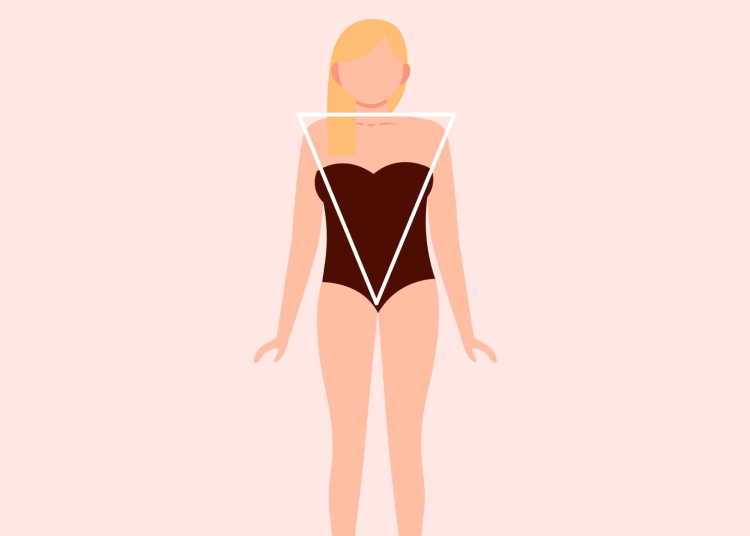
7. Oval Body Shape
A round midsection with skinny limbs typifies the oval body shape. The body is soft and flabby with very little muscular definition. The bust is generally well-endowed, and there is a minimal curve between the bust and hips.
Dressing tips for the oval body:
- Your goal should be to minimize attention on the midsection. Do this by choosing tops and dresses with an A-line silhouette that will give the impression of a more defined midsection.
- Use layers, such as jackets and vests, to enhance the length and create the illusion of a slim torso.
- Opt for materials that drape over the body rather than those that are clingy.
- Go for tops with V-necks or open collars that will help create a tall body illusion.
- Consider buying shapewear that will help support the midsection and create a smooth silhouette.
- Draw attention to your legs with above-the-knee skirts.
- Use accessories such as necklaces, scarves, and shoes that draw attention away from your waistline.
- Experiment with darker colors around the midsection and lighter colors on other parts of the body.
8. Diamond Body Shape
The diamond body shape is identified by a wide shoulder, a balanced or small bust, a narrow waist, and broad hips. The stomach area is wide and full, with excess weight in this area.
Dressing tips for the diamond body:
- Choose V-neck or open-neck tops that add length to the body and de-emphasize the waist.
- Go for A-line or flared skirts to add volume to the lower body and give the illusion of wider hips.
- Wear monochromatic outfits with vertical lines that will lengthen your silhouette and de-emphasize the waist.
- Stay away from tight-fitting clothing.
- Make use of jackets and blazers to balance out the body.
- Go with jeans that have a straight or wide leg that helps deliver a streamlined appearance.
- Choose dark colors around the midsection with lighter colors on the rest of the body.
- Wear heels to emphasize your legs and add length to the lower body.
- Add layers to create depth by throwing on a jacket or cardigan.
- Wear tops with vertical detail like seams and stripes to emphasize length rather than width in the upper body.
9. Top Hourglass Body Shape
The top hourglass body shape is characterized by a general hourglass figure with a bust that is slightly larger than the hips. The waist is smaller and more defined, and the hips are slightly curved.
Dressing tips for the top hourglass body:
- Emphasize the waist by choosing outfits with belts or that cinch at the waist.
- Wear wrap-around dresses and peplum tops.
- Go for outfits that hug your curves, such as tailored dresses, skirts, and tops.
- Choose V-necklines and sweetheart necklines that emphasize your neck and bust.
- Wear structured fabrics to highlight your curves.
- Go for flared and A-line bottoms to add volume to the lower body.
- Stay away from shapeless clothing.
- Buy well-fitting undergarments, including a supportive bra.
- Wear high-waisted skirts and pants to help produce an impression of length.
- Use dark colors around the middle of your body and lighter colors above and below.
10. Bottom Hourglass Body Shape
The bottom hourglass body shape is identified by hips that are slightly wider than the bust. The waistline is slim and defined. This body shape has full, rounded thighs and hips to create an out-of-proportion lower body. The shoulders and hips usually align.
Dressing tips for the bottom hourglass body:
- Emphasize the waist by choosing clothing that cinches at the waist, including belts and fitted dresses.
- Go for figure-hugging clothes that are tailored or produce a fitted silhouette.
- Wear structured tops that have detailing around the bust and shoulders.
- Buy A-line or flared skirts that will accentuate your hips and thighs.
- Go for jeans with a flare or a bootcut that will help accentuate your curves.
- Use jackets and blazers to layer your outfit.
- Wear off-the-shoulder tops to give the impression of wider shoulders.

Read also: Guide to Male Body Types (Ectomorphs, Mesomorphs, and Endomorphs)
Female Body Shapes Summary Chart
You may immediately identify your body shape from the abovementioned descriptions. If you don’t, here’s a handy summary chart that focuses on the differences between the bust, waist, and hips:
| Body Shape | Bust | Waist | Hips |
| Hourglass | Equal to or slightly larger than the hips | Smaller than the bust | Equal to or slightly larger than the bust |
| Pea | Smaller than the bust | Smaller than the bust | Larger than the bust |
| Rectangle | Equal to or slightly larger than the hips | Equal to or slightly larger than the bust | Equal to or slightly larger than the hips |
| Apple | Equal to or slightly larger than the hips | Larger than the bust | Smaller than the bust |
| Inverted Triangle | Larger than the hips | Smaller than the bust | Smaller than the bust |
| Diamond | Equal to or slightly larger than the hips | Smaller than the bust | Equal to or slightly larger than the bust |
| Top Hourglass | Larger than the hips | Smaller than the bust | Equal to or slightly larger than the bust |
| Bottom Hourglass | Smaller than the bust | Smaller than the bust | Larger than the bust |
| Oval | Larger than the hips | Larger than the bust | Equal to or slightly larger than the hips |
| Apple | Equal to or slightly larger than the hips | Equal to or slightly larger than the bust | Equal to or slightly larger than the hips |
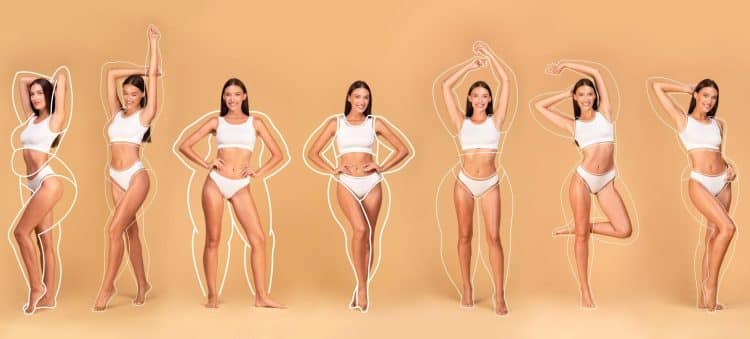
How To Use Body Measurements to Determine Your Body Shape?
To work out your body shape measurements, you must measure yourself in four places:
- Shoulders
- Bust
- Waist
- Hips
When taking measurements, wear something light, like a camisole. If you aren’t used to taking measurements, ask a friend to help you. With some practice, though, you should be able to take your measurements yourself. Here’s how to take your measurements accurately:
Shoulders
Place the tape measure around your shoulders as high up as possible without it slipping off. Make sure that the tape is at the same height on both sides. Record that measurement.
Related: Average Shoulder Width For Men and Women
Bust
Measure around the fullest part of your bust. Making sure that the tape doesn’t drop or droop in the back. Pull the tape taut but not too tight. Record that measurement.
Waist
Take your waist measurement around the belly button. For some people, the natural waist may be slightly higher than the belly button. You’re looking for the tiniest part of your waist. Again, the tape measure should be taut but not too tight. Record that measurement.
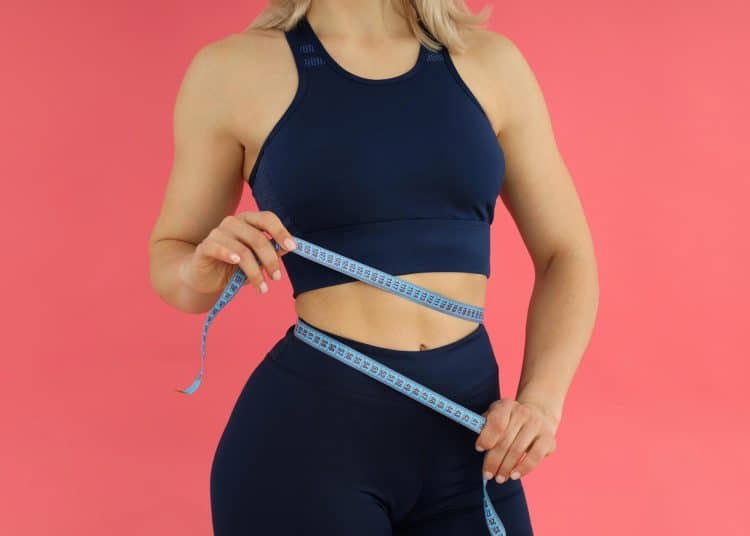
Related: Average Waist Size For Women and Men
Hips
Measure around the fullest part of your hips. This may be right at the hip bone or slightly lower. Record that measurement.
Now that you have taken the time to record your four key measurements make sure to use them when you’re ordering clothes online. Always check out the sizing guide on the seller’s website. Cross-check your bust, waist, and hip measurements with the sizing chart. If it is in between, always size up.
Now, here’s how to use your measurements to determine your body shape:
- If your shoulder measurement is larger than your hips by two or more inches, or your bust measurement is larger than your hips by four or more inches, you are an inverted triangle
- If your hip measurement is larger than your bust or shoulder measurement by two or more inches or larger than your bust by four inches or more, then you are a triangle. This is the most common body shape among women.
- If your waist is larger than your bust, shoulders, and hips by two or more inches, then you are a circle.
- If your shoulder, bust, hip, and waist measurements are all about the same, you are a rectangle. Your waist differential to your hips will be less than eight inches.
- If your shoulders, bust, and hips are very similar and the waist is eight or more inches less than the hips, you have an hourglass figure. This is the most desired body shape.
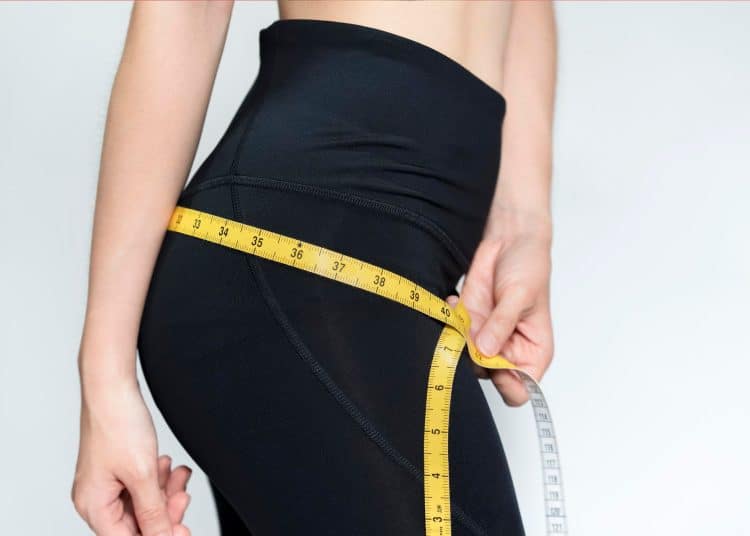
Related: Average Butt Size For Women and Men
Are You Long or Short Waisted?
Women who know whether they are long or short-waisted can create balance and proportion in their dress style. For example, those with a long waist may be better off going for high-waisted pants with thick belts to reduce the appearance of a long waist. On the other hand, people with a short waist might opt for a crop top to give the impression of a longer waist.
Here is how to determine if you have a short or a long waist:
- Stack your open hands on top of each other with palms against your skin directly under your bust.
- If your lower hand covers, or goes below, your belly button, then you are short-waisted.
- If your belly button is below your lower hand, you are long-waisted.
- If your second hand is right at your belly button, you are proportionate.
FAQs
What are the factors that control your body shape?
A person’s bone structure can have an impact on their body type. For instance, a person with a wide hip bone structure and a narrow shoulder girdle will tend towards a triangle-shaped body. A person’s height can also affect their body shape. For example, taller people may appear to have a more elongated torso, tending toward a rectangular body shape.
Genetics also plays a part in determining your body shape. Your genetics determines how rapidly you gain or lose weight. It also dictates what parts of your body you store excess calories in.
Another factor that determines your body shape is hormones. Two hormones that are involved in fat storage are estrogen and progesterone. Your ability to control your body weight and minimize fat storage will largely depend on the levels at which your body produces these hormones.
Is it possible to change body shape?
Yes, it is possible to make changes to your body shape. However, because some of the key determinants of your body shape, such as your bone structure, height, and hormone production levels, are unchangeable, these changes to your body shape will not be major. The main way to change your body shape is to either lose stored body fat or gain lean muscle tissue.
Is there a universally desired body shape?
No, there is no universally desired body shape. However, in the Western world, the preference is for the hourglass figure with minimal body fat; other cultures prefer body shapes with more stored fat.
Conclusion
As we’ve seen, women come in all shapes and sizes, and each body shape is uniquely beautiful. Once you have identified your body shape, embrace it and love it. You may decide to make changes to it by reducing body fat and increasing lean muscle tissue. The most important thing is, rather than trying to attain some imaginary, idealized body shape, you must follow lifestyle practices, including regular exercise and healthy eating, to ensure your body is as healthy as possible.
